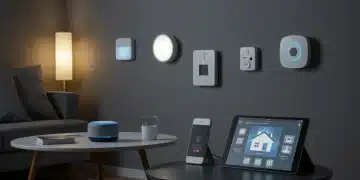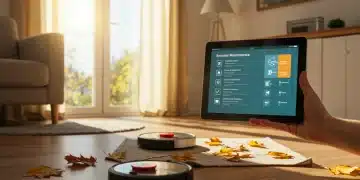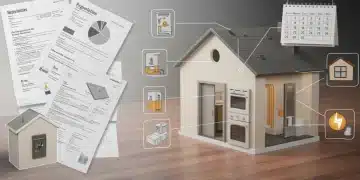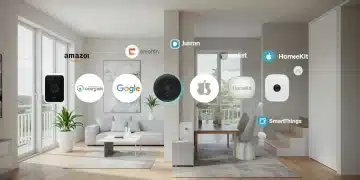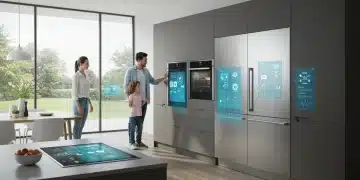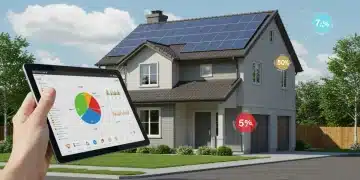Smart Locks 2025: Trends & Security for US Homes (UPDATES)
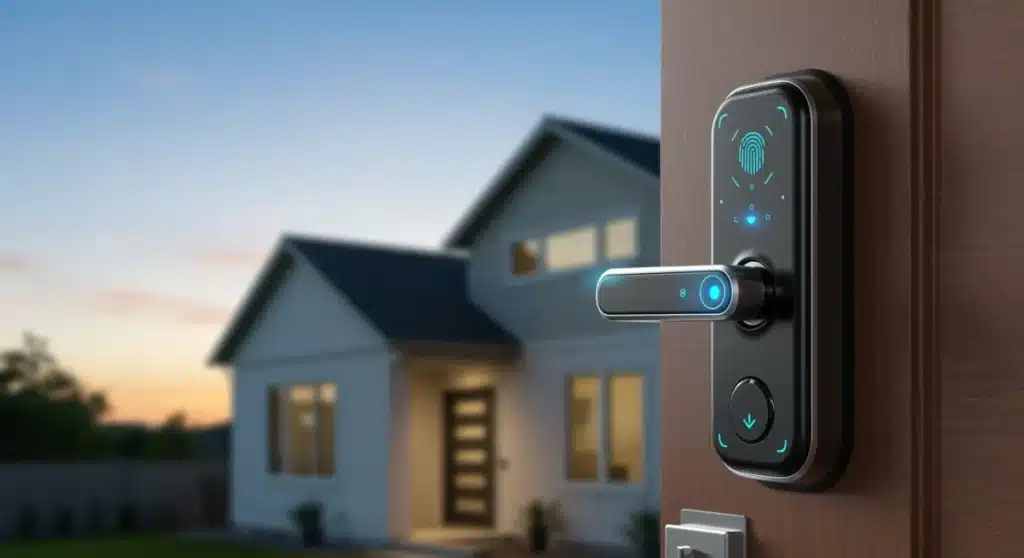
The future of smart locks in US homes by 2025 is rapidly evolving, with significant advancements in biometric authentication, AI integration, and enhanced cybersecurity measures, promising unprecedented security and convenience for homeowners.
Recent updates indicate that The Future of Smart Locks: 2025 Trends and Security Enhancements for US Homes (RECENT UPDATES) is rapidly approaching, bringing with it a wave of innovation set to redefine home security. Homeowners across the United States are on the cusp of experiencing unprecedented levels of convenience and protection.
Emerging Biometric Authentication Standards
As of late, biometric authentication is no longer a futuristic concept but a rapidly integrating reality in smart lock technology. By 2025, expect these advanced methods to become standard offerings, moving beyond simple fingerprint scans to more sophisticated solutions.
The drive for enhanced security and seamless user experience fuels this shift. Consumers are increasingly demanding authentication methods that are both robust and effortless to use, pushing manufacturers to innovate at an accelerated pace.
Advanced Biometric Modalities
Beyond traditional fingerprint recognition, new biometric modalities are gaining traction, promising even greater security and convenience for US homeowners.
- Facial Recognition: Utilizing advanced AI algorithms, smart locks will accurately identify authorized individuals, even in varying lighting conditions.
- Iris Scans: Offering an extremely high level of unique identification, iris scanning is set to provide an almost unbreachable layer of security.
- Voice Authentication: Integrating with smart home assistants, voice commands will unlock doors after verifying the user’s vocal print.
These developments are not just about convenience; they are about creating a multi-layered security approach that significantly reduces vulnerabilities associated with traditional keys or passcodes.
AI and Machine Learning Integration for Predictive Security
The integration of Artificial Intelligence (AI) and Machine Learning (ML) is fundamentally transforming how smart locks operate, moving from reactive security to proactive, predictive protection. This shift is critical for enhancing overall home safety by 2025.
Smart locks equipped with AI can learn user habits, identify anomalies, and even predict potential security threats before they materialize. This intelligent layer adds a significant advantage over conventional security systems.
Behavioral Pattern Recognition
AI algorithms analyze daily routines, understanding when residents typically come and go. This learned behavior allows the system to flag unusual activity, such as a door unlocking at an uncharacteristic time or an unfamiliar access attempt.
Furthermore, ML models continuously refine their understanding of ‘normal’ behavior, adapting to changes in household schedules and improving accuracy over time. This reduces false alarms while maintaining vigilance.
- Anomaly Detection: AI identifies deviations from established routines, instantly alerting homeowners to suspicious events.
- Real-time Threat Assessment: Machine learning algorithms process data from sensors to assess the severity of potential threats.
- Adaptive Security Protocols: Locks can automatically adjust their security settings based on threat levels, for example, requiring multi-factor authentication during suspicious periods.
This predictive capability means smart locks are becoming more than just access control devices; they are evolving into intelligent guardians of the home.
Enhanced Cybersecurity Measures and Data Privacy
With increasing connectivity comes heightened cybersecurity risks. By 2025, smart lock manufacturers are prioritizing robust cybersecurity measures and stringent data privacy protocols to protect US homes from digital threats.
Recent reports highlight the critical need for stronger encryption and secure data handling. Consumers are rightly concerned about their personal data, including biometric information, being compromised.
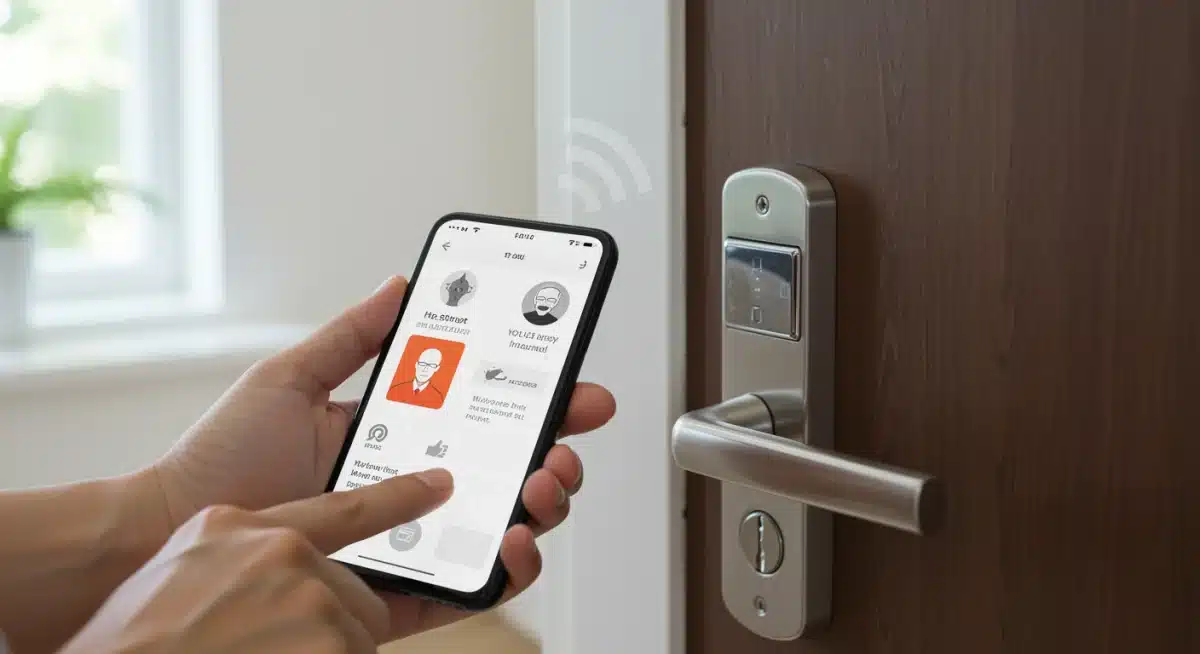
Advanced Encryption and Secure Communications
Manufacturers are implementing state-of-the-art encryption standards for all communications between the smart lock, mobile apps, and cloud servers. This ensures that data transmissions remain private and protected from interception.
Secure boot mechanisms and firmware over-the-air (FOTA) updates are also becoming standard, safeguarding devices from unauthorized modifications and ensuring that the latest security patches are always applied.
- End-to-End Encryption: All data, from biometric scans to access logs, is encrypted from the moment it’s captured until it’s stored or processed.
- Regular Security Audits: Independent cybersecurity firms conduct frequent audits to identify and rectify vulnerabilities.
- Data Minimization: Only essential data is collected and stored, reducing the overall risk in case of a breach.
These measures are crucial for building consumer trust and ensuring that the convenience of smart locks does not come at the expense of privacy or security.
Seamless Integration with Smart Home Ecosystems
The evolution of smart locks by 2025 is deeply intertwined with their ability to seamlessly integrate into broader smart home ecosystems. This convergence offers homeowners unparalleled control and automation.
Compatibility with major smart home platforms like Apple HomeKit, Google Home, and Amazon Alexa is becoming a non-negotiable feature, allowing locks to interact with other devices for enhanced safety and convenience.
Interoperability and Automated Routines
Smart locks are no longer isolated devices; they are integral components of a connected home. This interoperability enables complex automated routines that enhance security and simplify daily life.
For example, when a smart lock detects that the door is locked and everyone has left, it can trigger other actions, such as turning off lights, adjusting the thermostat, and arming the security system.
- Unified Control: Manage all smart home devices, including locks, from a single app or voice command interface.
- Geofencing Capabilities: Locks can automatically unlock as you approach home and lock when you leave, based on your smartphone’s location.
- Event-Triggered Automation: An unlocked door can trigger indoor cameras to record, or lights to turn on, creating a comprehensive security response.
This level of integration transforms a collection of smart devices into a truly intelligent and responsive home environment.
Powering the Future: Advanced Energy Solutions
The reliability of smart locks hinges significantly on their power sources. By 2025, advancements in energy efficiency and alternative power solutions are addressing previous concerns about battery life and maintenance.
Manufacturers are exploring innovative ways to extend operational periods and reduce the frequency of battery replacements, ensuring continuous security without constant user intervention.
Longer Lasting Batteries and Energy Harvesting
New battery technologies, including higher capacity lithium-ion cells and more efficient power management systems, are significantly extending the life of smart lock batteries. Some models now promise several years of operation on a single charge or set of batteries.
Furthermore, research into energy harvesting technologies, such as small solar panels integrated into outdoor components or even kinetic energy capture from door movements, aims to provide supplementary power, further reducing reliance on traditional batteries.
- Optimized Power Management: Locks are designed to consume minimal power when idle, only drawing more energy during active use.
- Rechargeable Battery Options: Many new smart locks offer rechargeable battery packs, reducing waste and long-term costs.
- Low-Power Wireless Protocols: Adoption of protocols like Bluetooth Low Energy (BLE) and Zigbee conserves energy during communication.
These power innovations are making smart locks a more sustainable and hassle-free component of modern home security.
User Experience and Accessibility Innovations
The focus on user experience (UX) and accessibility is paramount in the development of smart locks for 2025. Manufacturers are striving to make these advanced security devices intuitive for everyone, regardless of technical proficiency or physical ability.
This includes simplified installation processes, user-friendly interfaces, and features designed to accommodate individuals with diverse needs, ensuring smart locks are truly inclusive.
Intuitive Interfaces and Voice Control
Smart lock apps are becoming remarkably intuitive, featuring clean designs and straightforward controls that allow users to manage access, view activity logs, and customize settings with ease. Voice control integration with smart assistants is also enhancing accessibility, allowing hands-free operation.
Physical designs are also evolving, with tactile feedback and clear indicators for lock status, making them easier to use for those with visual impairments. The goal is to make interacting with a smart lock as natural and effortless as possible.
- Simplified Setup: Step-by-step guides and augmented reality (AR) features assist with initial installation and configuration.
- Customizable Access: Easily grant temporary or recurring access to guests, service providers, or family members via the app.
- Auditory and Visual Cues: Locks provide clear sounds and light signals to confirm lock/unlock actions, beneficial for all users.
These UX and accessibility innovations are key to widespread adoption, ensuring that the benefits of smart lock technology are available to the broadest possible audience.
Market Growth and Adoption in US Homes
The market for smart locks in US homes is experiencing significant growth, a trend projected to accelerate rapidly towards 2025. This surge is driven by increasing consumer awareness of smart home benefits and falling technology costs.
Reports indicate a strong upward trajectory in adoption rates, with more homeowners recognizing the value of enhanced security, convenience, and integration that smart locks offer.
Factors Driving Adoption
Several key factors are contributing to the expanding presence of smart locks in American households. These include technological advancements that make devices more reliable and secure, as well as a greater understanding among consumers of the practical advantages.
The COVID-19 pandemic also played a role, accelerating the demand for contactless and remote management solutions for homes. This shift in consumer behavior has solidified smart locks as a critical component of modern living.
- Increased Awareness: Homeowners are better informed about the security and convenience benefits.
- Affordability: The cost of entry-level smart locks has become more accessible, attracting a wider demographic.
- Ease of Installation: Many smart locks are designed for DIY installation, removing the need for professional help and reducing overall costs.
As competition grows among manufacturers, innovation continues, leading to even more advanced and user-friendly products that meet the diverse needs of US homeowners.
| Key Trend | Brief Description |
|---|---|
| Biometric Authentication | Advanced fingerprint, facial, and iris recognition for enhanced security and convenience. |
| AI & Machine Learning | Predictive security, anomaly detection, and adaptive protocols based on learned user behavior. |
| Cybersecurity Focus | Robust encryption, secure communications, and regular audits to protect user data and privacy. |
| Seamless Integration | Improved interoperability with smart home ecosystems for unified control and automation. |
Frequently Asked Questions About Smart Lock Trends
By 2025, smart locks will feature advanced biometric authentication like facial and iris recognition, coupled with AI-driven anomaly detection. Enhanced end-to-end encryption and secure firmware updates will also become standard, significantly bolstering protection against both physical and digital threats.
AI and ML will enable smart locks to learn user behavior patterns, predict potential security risks, and adapt their protocols in real-time. This includes identifying unusual access attempts or departures, providing proactive alerts and automatically adjusting security settings for greater responsiveness.
Data privacy is a critical focus, with manufacturers implementing robust encryption for all transmitted and stored data. Strict data minimization policies ensure only essential information is collected, and regular security audits aim to protect sensitive user data, particularly biometric information, from breaches.
Absolutely. By 2025, seamless integration with major smart home ecosystems like Apple HomeKit and Amazon Alexa will be standard. This allows for unified control, geofencing capabilities, and event-triggered automation, enabling locks to interact intelligently with lights, thermostats, and security cameras for a cohesive smart home experience.
Yes, significant advancements are underway. Expect longer-lasting batteries through optimized power management and higher-capacity cells. Additionally, research into energy harvesting technologies, such as small solar panels or kinetic energy capture, aims to provide supplementary power, reducing the need for frequent battery replacements and improving reliability.
What This Means
The rapid evolution of smart locks towards 2025 signifies a pivotal moment for US home security. These ongoing developments are not merely incremental upgrades; they represent a fundamental shift towards more intelligent, integrated, and resilient home protection systems. Homeowners should anticipate a future where security is both robust and effortlessly managed, driven by AI, advanced biometrics, and stringent cybersecurity. The coming years will consolidate smart locks as indispensable components of the modern, connected home, setting new benchmarks for safety and convenience.
